Working Time
- Mon-Thu 08:00 – 20:00
Friday 07:00 – 22:00
Saturday 08:00 – 18:00
Contact Info
-
Phone: 1300-22-0202
Ask the Experts
Hair Loss Solution:
Find Your Personalized Treatment
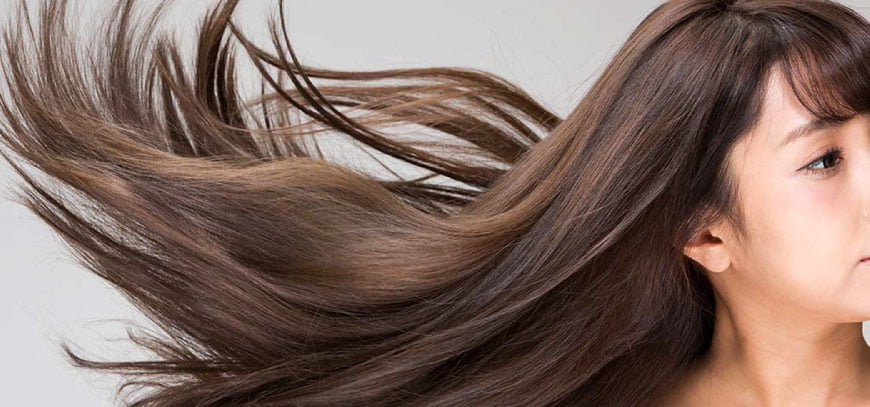
Scalp and Hair Loss Treatment
On average, a normal individual sheds approximately 100 strands of hair daily where it is a natural phenomenon of the hair growth cycle. When this balance is disturbed and more hair is shed than regrown, hair loss or alopecia is the outcome.
Hair loss can be a cosmetic problem when too much shedding occurs in the wrong place at the wrong time in a particular person. Scalp treatment for hair loss can help to support the hair growth and strengthen the hair follicles.
What are the causes of hair loss?
People always wonder what causes their hair loss. One of the commonest cause of hair loss is genetic, also known as androgenetic alopecia which affects 50% of male and female above 50 years old.
Stressful and poor lifestyle choices plays a significant role in hair loss such as lack of sleep, smoking habits, sudden drastic diet programs. Not to forget, certain diseases or illnesses and oral medications can cause hair loss. Moveover, hormones (post pregnancy, hypothyroidism, PCOS), trauma or infections (Trichotillomania, Syphillis, scalp infections), autoimmune diseases (Alopecia areata, Discoid Lupus Erythematosus) are the less common causes.
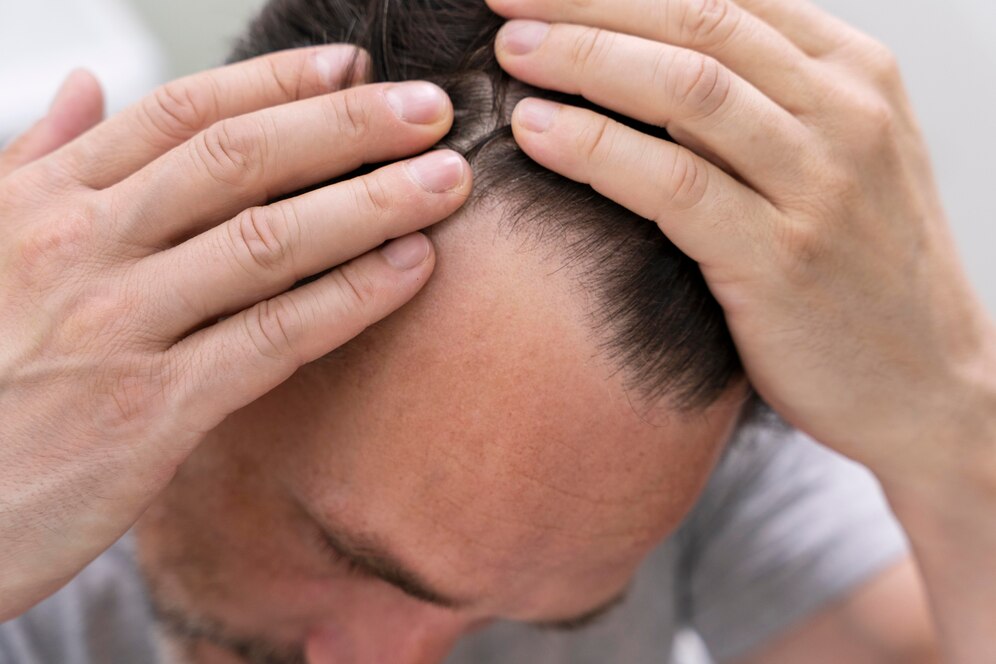
Male Pattern Baldness
The most prevalent form of hair loss in adult males is known as androgenetic alopecia, commonly referred to as male pattern baldness. This type of hair loss is closely intertwined with genetic factors and male sex hormones. The characteristic progression of male pattern baldness initiates at the hairline, gradually receding and resulting in hair loss at the frontal and top regions of the head. This process shapes the hair loss pattern into both an “M” and “O” formation. Additionally, the vertex, a circular area on the back of the head, often experiences thinning and expansion over time. Eventually, the hair undergoes a transformation, becoming finer, shorter, and thinner, ultimately giving rise to a distinctive U-shaped (or horseshoe) arrangement of hair along the sides of the head, coupled with a bald patch on the posterior part of the head.
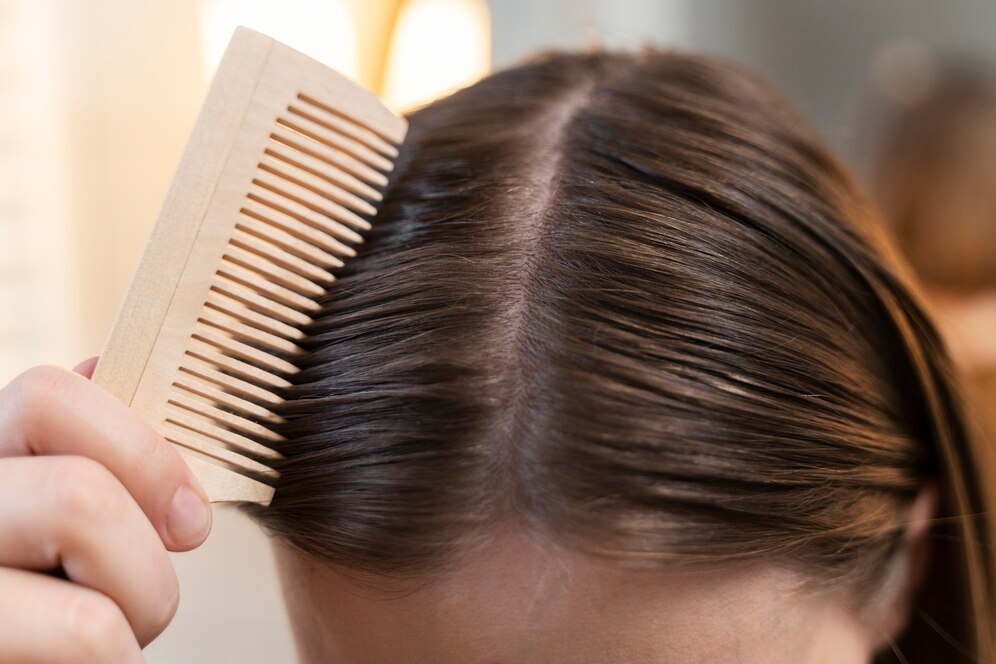
Female Pattern Baldness
Female pattern baldness pertains to a form of hair loss that impacts individuals who are women or were assigned female at birth. This condition leads to the shedding of hair from the surface of the scalp and does not naturally regenerate without intervention. Typically, female pattern baldness commences following menopause. Its manifestation differs significantly from the more readily recognizable male pattern baldness, which usually begins with a receding frontal hairline and advances to the development of a hairless area on the crown of the head.
The likelihood of experiencing female pattern baldness increases with advancing age; approximately 40% of women exhibit indications of hair loss by the age of 50, and fewer than 45% of women maintain a complete head of hair upon reaching 80 years of age.
Balding at a Young Age
Hair loss can be particularly distressing for young individuals, catching them off guard. The causes of hair loss in youth are diverse, encompassing genetics, hormonal imbalances, stress, inadequate nutrition, crash diets, and even certain hairstyling practices. As people age, hair loss becomes an intrinsic facet of the natural process, more prevalent as time passes. In later years, factors such as hormonal shifts, genetic predisposition, age-related health concerns, decreased hair follicle activity, and the influence of medications contribute to the occurrence of hair loss.
When should you see us?
Symptoms are quite apparent and distressing for hair loss. You may find much more hair on your pillow or in your comb than usual. Besides, these are the few important signs:
- Progressive thinning of hair at the top of your crown
- Receding hair line
- Patchy bald spots
In O2 Klinik, we adopt the analogy of having ‘green fingers’ when it comes to hair restoration. We plant, we nurture and we nourish.
O2 Klinik provides a wide range of hair growth and scalp treatment for hair loss to meet individual expectations such as:
- Finasteride and Topical Minoxidil
- Hair filler treatment
- Hair PRP
- Biofibre Hair Implant
- Follicular Unit Extraction (FUE) Hair Transplant
- Hair products
Finasteride and Topical Minoxidil
Oral Finasteride
Oral Finasteride is useful to block DHT (Dihydrotestosterone), the primary hormone responsible for hair loss in men. That is why, one of the most effective way to slow down and prevent hair loss is to block DHT.
Q: How long does it take for finasteride to help with hair loss?
A: In general, it may take several months before noticeable changes in hair growth are observed. Most studies suggest that significant improvements in hair density and hair regrowth are typically seen after approximately three to six months of consistent use.
Q: Will men get erection problem after taking Finasteride?
A: Some individuals may have decreased libido and weaker erection during the first few weeks of treatment and subsides naturally after that.
Topical Minoxidil
A hair spray that is used daily that works by vasodilating the scalp vessels, improving the blood circulation of the scalp and thus, allows more nutrients and oxygen to flow in the scalp area.
Q: How long can I stay on Minoxidil?
A: It is a long term hair growth treatment and has to be used regularly. You will see the hair growth and thickening after 2-3 months of application.
Q: Who should not use Minoxidil?
A: Minoxidil is a medication commonly used topically to promote hair growth in conditions like androgenetic alopecia (male and female pattern baldness). While generally considered safe, there are certain individuals who should avoid or use caution when using minoxidil. Here are some groups of people who should exercise caution or avoid minoxidil:
– Pregnant or Breastfeeding Women
– Individuals with Hypersensitivity or Allergies
– Individuals with Scalp Infections or Irritations
– Individuals with Cardiovascular Issues
– Individuals with Other Skin Conditions
– Children (with the guidance and supervision of a healthcare professional)
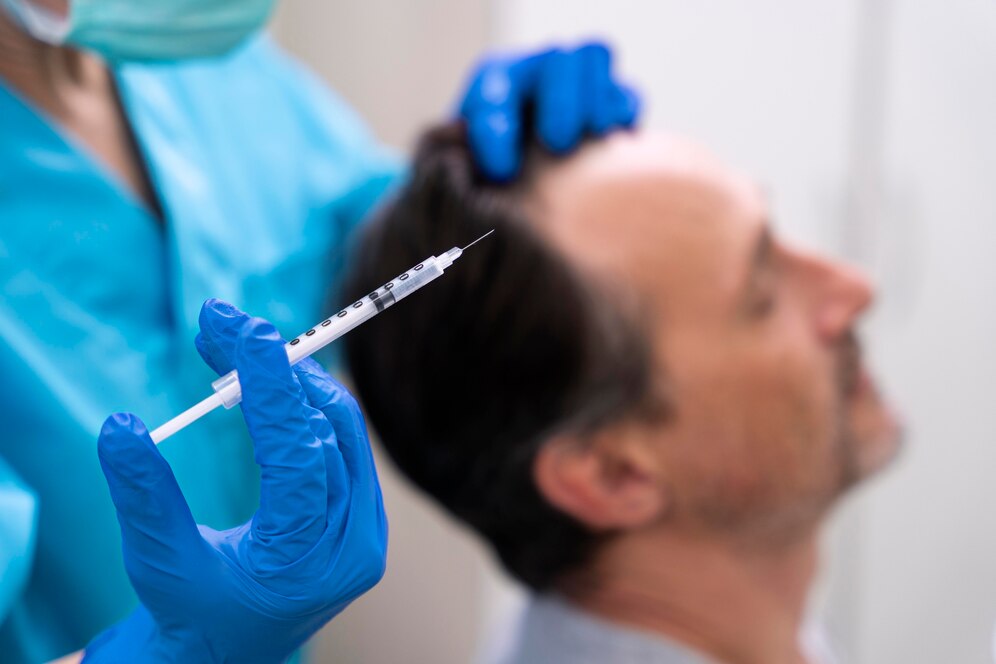
Hair Filler Treatment
Hair filler consists of combinations of 7 patented protein peptides (Decapeptide-28, Decapeptide-18, Decapeptide-10, Oligopeptitde-71, Oligopeptitde-54, Octapeptide-2, and Octapeptide-11), Phosphate buffered saline and hyaluronic acid that can be effectively transferred and absorbed into hair follicles. It promotes blood circulation in the scalp and revitalizes hair follicles thus inducing hair growth by increasing the size of follicles and restoring hair thickness.
As per protocol, treatment is carried out as 1 session every 2 weeks for 8 weeks (4 sessions in 2 months).
Q: Who is suitable for Hair Filler treatment?
A: Patients with general hair thinning: Support hair and scalp treatment.
Alopecia patients (bald patches): Alopecia patients who want to have a synergic effect combining with other applications for hair loss or hair regrowth treatments.
Hair transplant patients: for patients who want to increase the survival rate of their transplanted hair.
Q: How safe is Hair Filler procedure?
A: Hair Filler is a fairly safe procedure. Patients may experience slight redness, swelling, bruising, itching or mild pain at the injection area after the treatment. It would usually subside over 24 hours.
Q: How many sessions of hair filler?
A: A monthly maintenance treatment every 6 months post-treatment is recommended to sustain the effects of the treatment.
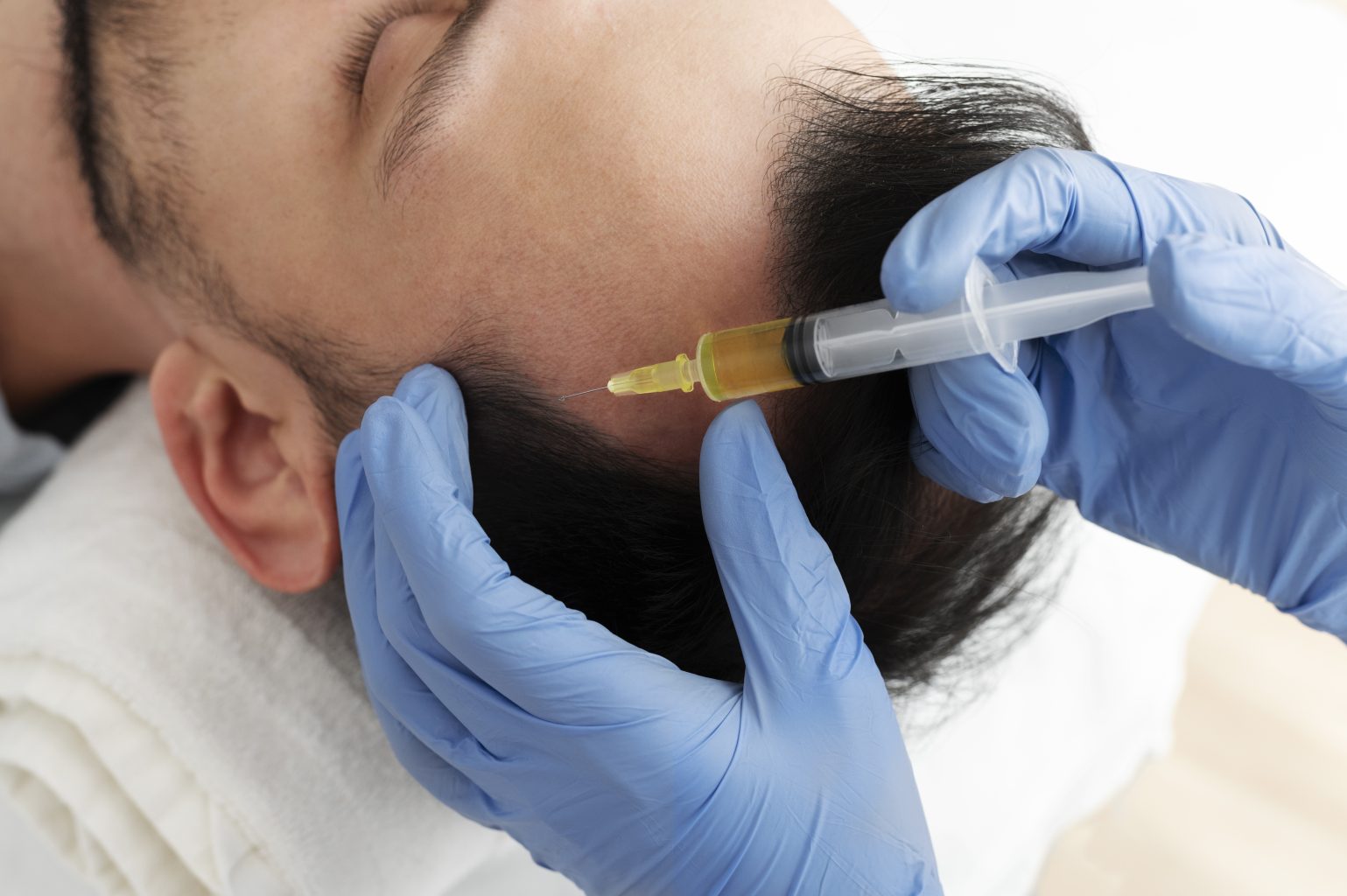
Hair PRP
Platelet-rich plasma (PRP) therapy for hair loss is a simple treatment where a person’s blood is drawn, processed and then injected into the scalp. This plasma contains white blood cells and platelets, which are rich in growth factors that play the role of messengers, signalling and stimulating inactive hair follicles into producing new hair.
Q: Any downtime?
A: You may experience minimal swelling or mild bruising up to 2 days which will subside after that. Otherwise, you are able to wash your hair immediately after treatment.
Q: Any side effects? Will I contract blood borne diseases from this procedure?
A: There are little risks known for this procedure as the blood is from you. Rest assured that new needles and syringes are used for each patient. Therefore, there is no risk of contracting blood borne diseases.
Q: When can I see the result of my PRP?
A: Patient can notice the visible result as early as 2nd month after the injection, and best seen after 6 months.
Q: How many sessions are required?
A: Varies between individual, as it depends on degree and severity of hair loss. Schedule an appointment at O2 Klinik for consultation with our hair doctor.
Q: Who is suitable for this hair PRP?
A: PRP therapy for hair loss is generally considered suitable for individuals experiencing certain types of hair loss or thinning. It is often used for androgenetic alopecia, commonly known as male or female pattern baldness, but its effectiveness can vary from person to person. PRP may also be considered for other types of hair loss, such as alopecia areata or certain non-genetic causes.
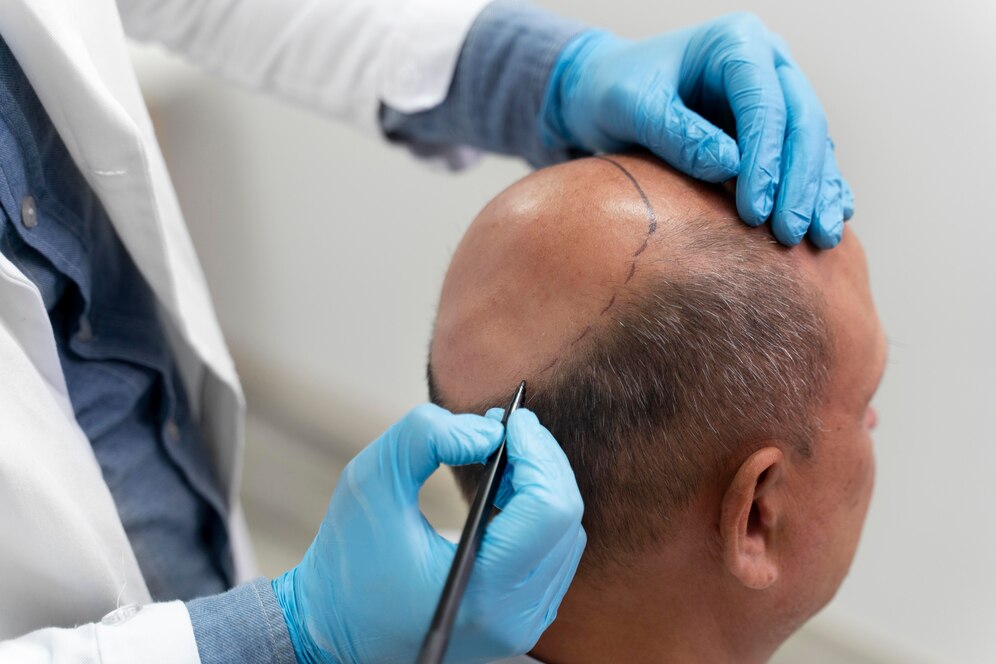
Biofibre Hair Implant
Biofibre hair implant is a safe, simple, minimally invasive aesthetic procedure for male and female baldness solution. It is inserted one by one on the scalp under local anaesthesia scalp without any pain or discomfort. It is considered a safe and effective procedure as multiple pre-clinical, clinical and histologic studies were conducted.Biofibre hair is made with advanced inert materials, not harmful for the human body and produces a keratin plug which prevents microbial agents from penetrating the pseudo-infundibulum.
Furthermore, it is resistant to flexing and tensile stress (over 300 gr.), does not break easily and has a special reversible knot, which ensures an excellent strength of the implant and, in case of need, allows complete fiber removal without leaving scars.
Q: How is the hair implant done?
A: Pre-procedure, our hair loss doctor will check whether the patient is suitable for this treatment. If all is good, they will proceed to color and the type of hair selection (smooth or curly).The doctor will anaesthetize the area using local anaesthesia for a pain free procedure. Then, implantation of biofiber hair is done using a special implanter. Around 50 – 100 hairs are implanted and observed over 1 month for any signs of allergy. If there are no allergies, a full procedure is carried out after that.
Q: What are the advantages of getting hair implant?
-Does not turn to white hair
-Simple, fast, reversible and painless
-Better and greater hair density in a short time
-Outpatient procedure with no downtime and allows patient to return to daily routine
-Provides a gradual and progressive hair thickening to hide the patient’s hair loss problem
-Implant can be performed alone or in combination with other medical or surgical treatments
Q: How long do I have to wait until a Biofibre implant is stabilized?
A: The final fixing of implanted Biofibre is completed 20- 30 days after the implant performed to cover male or female baldness area or increase hair thickening and will remain unchanged for a long period of time.
Q: How often do I need to repeat the procedure?
A: The duration of result varies between individual depending on post implant care. Worry not as we have our team to help you with your post implant care. Research reports it can last 7-8 years on average with approximately 10% yearly biofibre loss. Yearly re-touch of Biofibre is done as a standard.
Q: Who is suitable for this Hair Implant?
A: Generally, hair implant is suitable for individuals experiencing permanent hair loss, particularly in cases of androgenetic alopecia (male or female pattern baldness).
Follicular Unit Extraction (FUE) Hair Transplant
FUE is a fairly new method in hair restoration where hair follicles from the donor area (the back and side of scalp where hair won’t fall out during the patient’s lifetime) are extracted one by one and transplanted to the recipient area. Take the analogy of moving multiple selected plants with its roots to a new garden.
This technique is a minimally invasive procedure which requires no linear incision or stitches and when done properly, it can hardly be seen even with short hair. However, if the head is shaved completely, many white dots can be seen.
Q: Am I a good candidate for FUE?
A: A proper consultation, assessment and discussion of expectations with the doctor is required before signing up for this procedure.
Q: Is the procedure painful?
A: You do not feel pain during the FUE hair transplant as it is performed under local anaesthesia. You might experience minimal discomfort during the administration of the local anaesthesia. Post-procedure, oral analgesia is given to prevent pain when the local anaesthesia wears off.
Q: How long does a hair transplant procedure like FUE will take?
A: It all depends on the number of grafts needed for the area of coverage. Usually, our patients will need at least 4 hours per procedure.
Q: How long does it take for hair to grow after hair transplant?
A: The donor area recovery is very fast, usually in two or three days, all the punch incisions will heal and no removal of stitches are required.
At the recipient area, the transplanted hair stabilizes and recovers within a week and starts to grow in around 3 to 4 months following the surgery and grows 1cm per month.
Q: Does FUE require a shaved head?
A: Follicular Unit Extraction (FUE) is a hair transplant technique where individual hair follicles are harvested one by one from the donor area and then transplanted into the recipient area. Whether a shaved head is required for an FUE procedure depends on the approach taken by the surgeon and the preferences of the patient.
In traditional FUE procedures, the donor area (usually the back and sides of the scalp) needs to be shaved for optimal access to individual follicles. This allows the surgeon to extract the follicles with precision. The extent of shaving can vary, and some clinics may only shave a small portion of the donor area to conceal the harvested sites.
However, some modern variations of FUE, such as “No-Shave FUE” or “Unshaven FUE,” have been developed to minimize the need for shaving the entire donor area. In these cases, only small areas where the follicles are being extracted may be shaved, while the rest of the hair is left unshaved.
What is the procedure like?
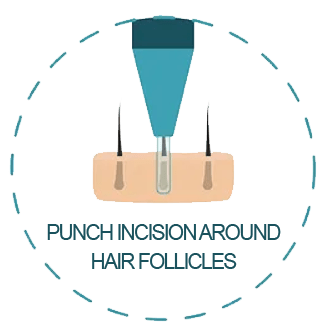
1
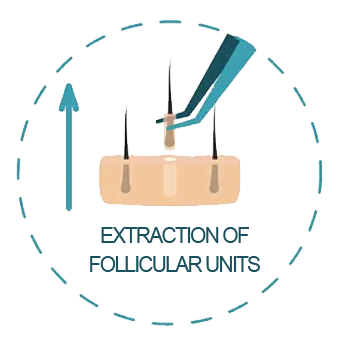
2
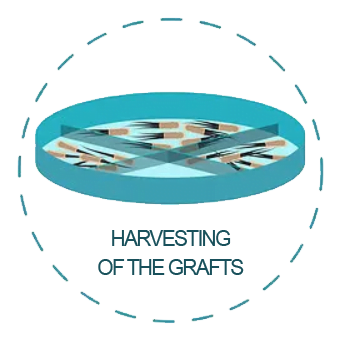
3
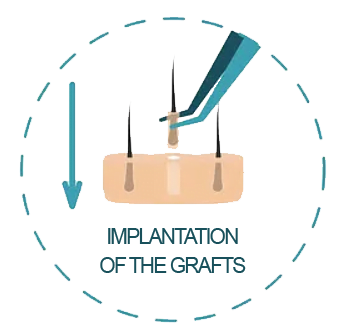
4
Frequently Asked Questions
Sed ut perspiciatis unde omnis iste natus error sit voluptatem accusantium doloremque laudantium, totam rem aperiam, eaque ipsa quae ab illo inventore veritatis et quasi architecto beatae vitae dicta sunt explicabo.
Sed ut perspiciatis unde omnis iste natus error sit voluptatem accusantium doloremque laudantium, totam rem aperiam, eaque ipsa quae ab illo inventore veritatis et quasi architecto beatae vitae dicta sunt explicabo.
Sed ut perspiciatis unde omnis iste natus error sit voluptatem accusantium doloremque laudantium, totam rem aperiam, eaque ipsa quae ab illo inventore veritatis et quasi architecto beatae vitae dicta sunt explicabo.
Sed ut perspiciatis unde omnis iste natus error sit voluptatem accusantium doloremque laudantium, totam rem aperiam, eaque ipsa quae ab illo inventore veritatis et quasi architecto beatae vitae dicta sunt explicabo.
Working Time
- Mon-Thu 08:00 – 20:00
Friday 07:00 – 22:00
Saturday 08:00 – 18:00
Contact Info
-
Phone: 1300-22-0202
